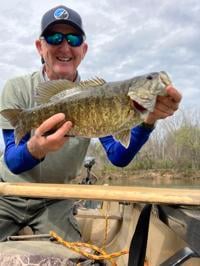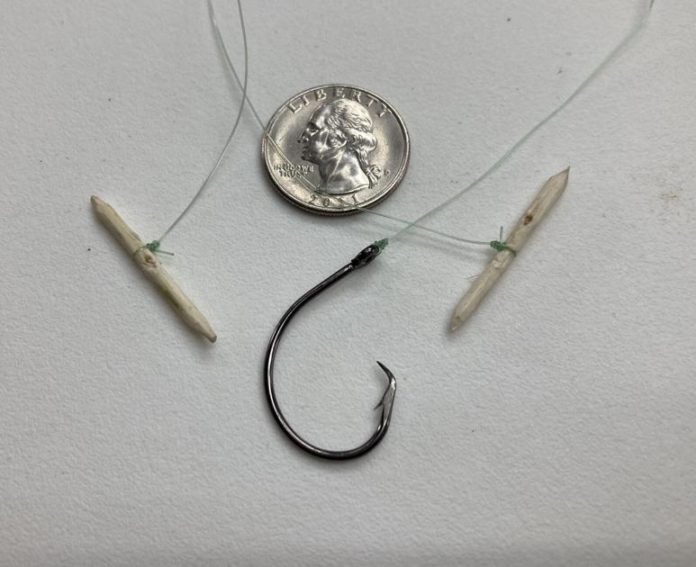Walk into a fishing tackle store to find a pack of hook and it can be overwhelming. Dozens and dozens of hooks in various sizes and styles made by different manufacturers. And the choice you make is very important. After all, that hook is the penultimate connection between you and the fish.
I got to thinking about how far fish hooks have come while watching a YouTube video by the Outdoor Boys with my grandsons Jon Thomas and Mac. The Outdoor Boys is a channel featuring a father and his three sons (and occasionally mom) enjoying outdoor adventures. This particular episode was titled “Primitive Survival Fishing Catch & Cook Camping Trip: No Hooks, Rods, Reels.”
The father and his youngest son (the two others were still in school) hiked to a nearby pond and began gathering earthworms to use as bait, and then the father began to carve out a fish gorge – predecessor of the fish hook. Imagine a shortened round toothpick, maybe an inch long, with a small notch in the middle in which to affix your fishing line.
After making several gorges, the father found a long stick to use as his fishing pole, attached some line and tied on one of the gorges. He then cut a section of earthworm about the length of the gorge and shoved the bait onto the gorge so just the very tips of the gorge were exposed, then tightened the line so that the gorge hung perpendicular to the line.
He explained that a gorge is not nearly as effective as modern fish hooks and doesn’t work that well on larger fish, but before long he had landed enough bluegills for an evening meal.
The fish can swallow the baited gorge, but when you pull back and put tension on the line the gorge turns sideways and lodges inside the fish. He used another stick to dislodge the gorge so he could put it on his stringer.
Fish gorges came along much later than the earliest fish hooks, which were made from shells and bones thousands and thousands of years ago. And steel fishing hooks have been around for hundreds of years.
When you look at the hook displays in modern tackle shops you will find two basic styles of hooks: the J-hook, so named because it is shaped like the letter J, and the circle hook. They come in sizes small enough to hook fish with tiny mouths up to giants designed to land large billfish or sharks. The barbed point of the J-hook is parallel to the shank.
More recently anglers have come to favor the circle hook in which the barb is turned toward the shank. Instead of having to set the hook, the hook is designed so as you tighten your line the circle hook generally catches in the corner of the fish’s mouth.
When it comes to catching fish, I don’t need more of a challenge. And I hope I’m never caught in a situation where I have to catch a fish in order to survive. But the Outdoor Boys and their fishing gorge intrigued me. So I spent some time this week carving out a few gorges and hope to try them out soon on some bream. The Outdoor Boys’ fish fry looked pretty tasty.

#Whoyouwhit fishing tournament
The #Whoyouwhit Benefit fishing tournament, fished in honor of Whit Nelson, will be held Oct. 23 at The Marina at Edisto Beach. Proceeds will benefit The National Institute of Mental Health and Project Healing Waters Fly Fishing.
America’s Boating Club
America’s Boating Club Charleston will hold boating safety classes Nov. 6, Dec. 4 and Jan. 15 at 1376 Orange Grove Road, Charleston. Classes begin at 9 a.m. and end around 4 p.m. Successful participants earn the S.C. Department of Natural Resources Boater Education Card. The cost is $25 for adults and youth 12-18 are free. Call 843-312-2876 or email lynes@tds.net.
ECOMC Turkey Shoot
The East Cooper Outboard Motor Club will hold its annual turkey shoot Nov. 3-24, Wednesdays through Saturdays, from 6:30-10 p.m. at Goldbug Island, located at 1560 Ben Sawyer, Mount Pleasant. The shoot also will be held the Monday, Tuesday and Wednesday before Thanksgiving. Last year the event donated $30,000 to Lowcountry charities and has raised $483,500 for charity since 1997.
Credit: Source link






























